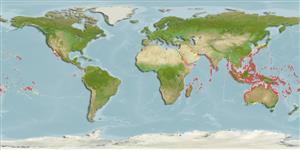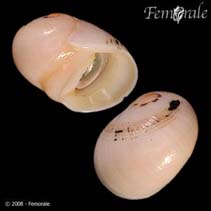Nerita polita Linnaeus, 1758
Polished nerite| Native range | All suitable habitat | Point map | Year 2050 |

|
| This map was computer-generated and has not yet been reviewed. |
| Nerita polita AquaMaps Data sources: GBIF OBIS |
Classification / Names Common names | Synonyms | CoL | ITIS | WoRMS
Gastropoda | Cycloneritida | Neritidae
Environment: milieu / climate zone / depth range / distribution range Ecology
Benthic; depth range 0 - 20 m (Ref. 109505). Tropical; 31°N - 37°S, 23°E - 128°W
Distribution Countries | FAO areas | Ecosystems | Occurrences | Introductions
Indo-Pacific: north to Japan, south to Australia and South Africa, west to East Africa and east to Pitcairn.
Length at first maturity / Size / Weight / Age
Maturity: Lm ? range ? - ? cm Max length : 4.0 cm SHL male/unsexed; (Ref. 349); common length : 3.0 cm SHL male/unsexed; (Ref. 349); max. reported age: 4 years (Ref. 8702)
Short description Morphology
This species can be distinguished by the following characters: shell thick, subglobose with flat spire; outer surface polished and smooth; columella smoth; presence of small denticles at inner margin of outer lip aperture. Colouration: shell variable white, cream, brown, dark grey or green, marbled, streaked or spotted; aperture and columellar shield glossy white (Ref. 128042).
This very common species is prized for food and for its attractive shell (Ref. 349). Depth range based on species' occurrence data in Taiwan (Ref. 109505); to be replaced with a better reference. Common in intertidal shores of Capiz (Ref. 128042). Usually buried in sand during the day and emerging at night to graze on nearby rocks (Refs. 349, 799). Exclusively herbivorous and feeds on algae (Ref. 122680). Also found in mangrove areas. Part of both epibenthic and arboreal communities (Ref. 128397).
Life cycle and mating behavior Maturity | Reproduction | Spawning | Eggs | Fecundity | Larvae
Members of the order Neritopsina are mostly gonochoric and broadcast spawners. Life cycle: Embryos develop into planktonic trocophore larvae and later into juvenile veligers before becoming fully grown adults.
Main reference
References | Coordinator | Collaborators
Poutiers, J.M. 1998. (Ref. 349)
IUCN Red List Status (Ref. 130435)
CITES status (Ref. 108899)
Not Evaluated
CMS (Ref. 116361)
Not Evaluated
Threat to humans
Harmless
Human uses
Fisheries: commercial
| FishSource | Sea Around Us
Tools
More information
Internet sources
BHL | BOLD Systems | CISTI | DiscoverLife | FAO(Publication : search) | Fishipedia | GenBank (genome, nucleotide) | GloBI | Gomexsi | Google Books | Google Scholar | Google | PubMed | Tree of Life | Wikipedia (Go, Search) | Zoological Record
Estimates based on models
Preferred temperature
(Ref. 115969): 24.3 - 29.3, mean 28.4 (based on 2814 cells).
Price category
(Ref. 80766):
Unknown.
Nutrients: Calcium = 126 [75, 177] mg/100g; Iron = 4.79 [1.67, 7.92] mg/100g; Protein = 15.9 [14.8, 16.9] %; Omega3 = 0.331 [0.263, 0.400] g/100g; Selenium = 57.8 [48.5, 67.2] μg/100g; VitaminA = 0 μg/100g; Zinc = 1.97 [0.92, 3.02] mg/100g (wet weight).



